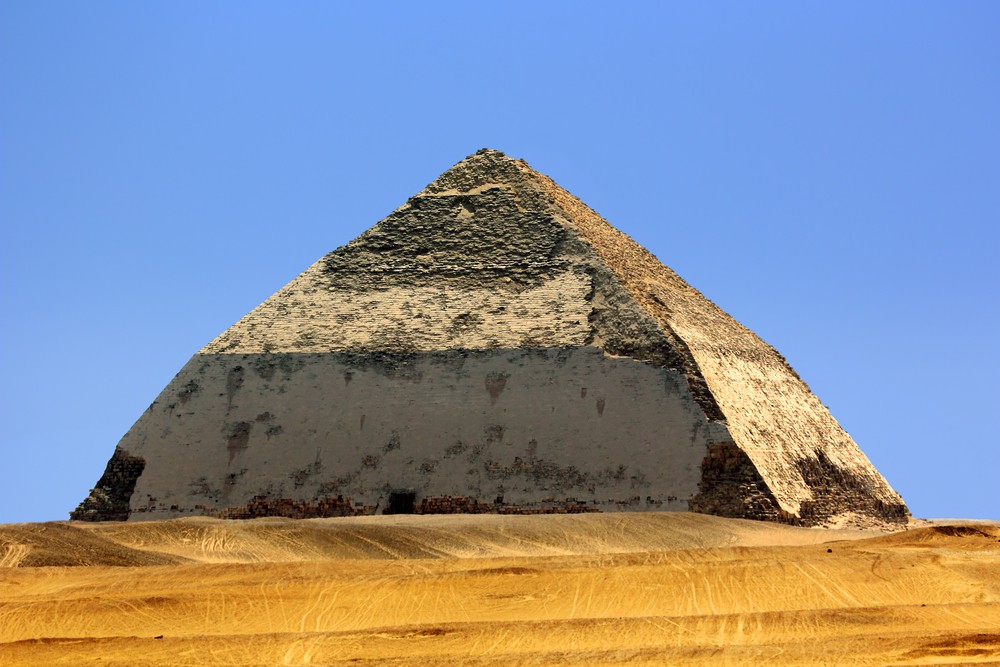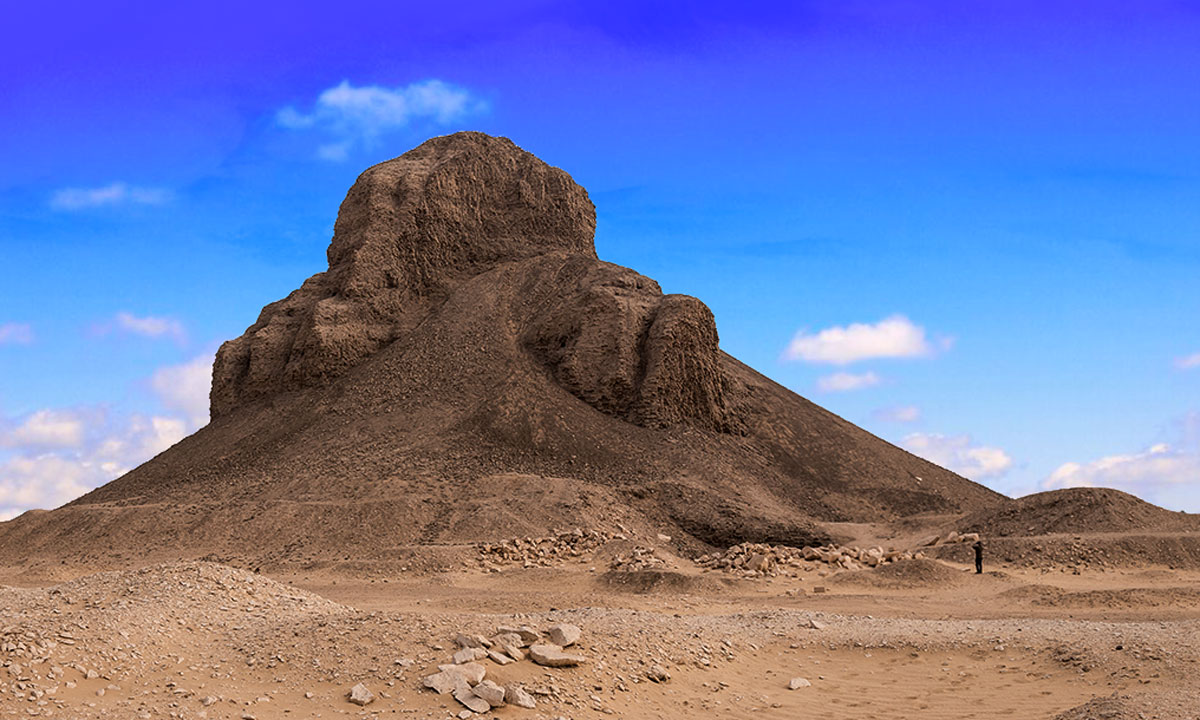
(Giza Pyramid complex.)
Until recently, it was believed that enslaved people built the pyramids. Misinterpretations of the biblical book of Exodus and written work by ancient Greek historian, Herodotus, have contributed to this theory. Although the idea that slaves were forced to build the pyramids is captivating, new evidence and research have debunked this long-believed theory. Archaeologists and historians conclude that paid laborers built the famous pyramids.
Hollywood has certainly enhanced the misconception. Cecil B. DeMille's iconic 1956 film, The Ten Commandments, and Ridley Scott's 2014 film, Exodus: Gods and Kings showcase examples of Moses bravely confronting a slave-driving Pharaoh to liberate his people. Images of famished slaves, clad in loincloths, hauling huge bricks while being whipped by their Egyptian overlords is a well-known depiction of how the famous pyramids of Egypt were built.
Historical Context Of Slavery In Ancient Egypt:
Slaves were a constant presence in Ancient Egypt. Beginning with the Old Kingdom (2613 - 2181 BCE), slaves carried out various roles. Some became soldiers while others became scribes. Many slaves were household servants.
The Old Kingdom lasted for about 500 years. During this time, slaves were acquired through wars. After defeating their enemies in battle, the conquered soldiers were captured and transported to Egypt, where they were forced into slavery. This was known as chattel slavery. Other chattel slaves were people found guilty of various crimes whose punishment included losing their freedom. Depending on the crime committed, the length of servitude could last up to a lifetime.
Records of King Sneferu reveal that the king enslaved captives from his campaigns in Nubia, Libya, and Sinai. These foreign-bonded slaves were drafted into the military. In some cases, foreign-bonded slaves could return to their homelands after their service in the military.
In the First Intermediate Period of Egypt (2181-2040 BCE), Egypt was divided between two powers. Het-Nesut ruled Lower Egypt and Waset ruled Upper Egypt. During this era, the inability to pay debts was the main reason why people were enslaved. When debtors were unable to pay, family members, mostly women, were sold into slavery, becoming bonded servants. In the Middle Kingdom (2040-1782 BCE), slaves from Asia attained various statuses, contributing to the community as servants, hairdressers, fieldworkers, cobblers, gardeners, and weavers. The Second Intermediate Period (1782 - 1570 BCE), saw changes in Egypt's slavery. During this time, slaves could become citizens of Egypt.
The most popular era in Egyptian history began with the New Kingdom (1570 - 1069 BCE). It was during this era that the famous pharaohs of the 18th, 19th, and 20th Dynasty reigned including Hatshepsut, Amenhotep III, Akhenaten, Nefertiti, Tutankhamun, Seti I, Ramesses II, and Ramesses III.
Within the New Kingdom, Egypt expanded to become an empire. To sustain these conquests, more soldiers were required. Slaves were captured and drafted from foreign lands. Many were acquired from the Mediterranean Market, which was operated by slave traders who were known to kidnap travelers and sell them on the market. During this period, Egyptian slaves were elevated in status and received more humane treatment than foreign slaves who were often traded or gifted as a reward.
The Myth Of Slaves Building Pyramids:
The myth of slaves building the pyramids is a misconception from the Bible. In the Book of Exodus, found in the Old Testament, it says Israelites were slaves in Egypt. Although the Bible does not mention the pyramids, it became popular belief that the famous structures were built by slaves.
In addition to the Bible, the myth spread through the written work of Herodotus. He was a Greek historian during the fifth century B.C. who traveled throughout the Persian Empire, Egypt, and Scythia. During his travels, Herodotus observed and documented local cultures. He finally settled in Italy where he refined his masterpiece, "The Persian Wars."
In his work, Herodotus wrote that the pyramids were built with slave labor. His writing specifies that 100,000 slaves were used. As a traveler and foreigner to Egypt, it is possible he simply misunderstood. Construction workers lived a short life and suffered from bad health from constant exposure to the sun. That said, they were still free men and ordinary citizens.
Archaeological Evidence Against The Slave Theory:
Graves of the builders who worked on the Pyramids of Giza were first found in 1990. Egyptologist and Secretary General of the Supreme Council of Antiquities, Zahi Hawass, confirmed the workers were paid laborers based on the location and care shown to bodies as they were prepared for burial. Builders were buried in tombs close to the pyramids, a place of honor, and furnished with supplies for the afterlife. The bodies were not mummified and were found in a fetal position with the head pointing to the west and feet to the east, in accordance with ancient Egyptian beliefs.
In addition, archaeologists discovered remnants of communities on the Giza plateau on the edge of Cairo. The ruins included gallery-style buildings which may have served as barracks for a rotating group of workers.
Some egyptologists theorize the pyramid builders consisted entirely of seasonal agricultural workers. However, written records mention a gang led by an inspector named Merer who traveled all over Egypt to complete various construction projects assigned to them. This evidence confirms some workers, at least this particular group, were part of a professional construction organization rather than only seasonal agricultural workers currently looking for off-season work.
Analysis Of Workers' Living Conditions:
Archeologists estimate about 20,000 laborers in addition to 16,000 support staff worked on the pyramid project in Giza. It was hard work to quarry and haul stone, build ramps, provide food and water, and supervise the worksite. Even with a massive workforce, construction spanned 20 to 30 years to complete a pyramid.
Temperatures in Egypt often reached over 90 degrees Fahrenheit (35 degrees Celsius). With high temperatures and laboring unshaded in the sun, workers wore light fabrics to keep cool. Men wore flax-based linen loincloths held up with a belt. The loincloths extended from waist to knee. Women secured linen sheaths with a shoulder strap.
Administrative documents kept accounts of the food and housing of workers, proving the working conditions to be decent. Animal bones uncovered at the archaeological site display a diet including fish, beef, goat, duck, and sheep. There is also evidence that fruit, dates, honey, cakes, beer, and bread were consumed. With a seemingly balanced diet, workers were well-fed to provide the energy needed for harsh weather and manual labor.
Additionally, workers received medical care. Excavators discovered broken bones that were well set. Skeletal remains show evidence of brain surgery and assistance with birth complications. Even with medical care, the life span of the average worker was 30 - 35 years old.
With harsh working conditions, laborers on the pyramids worked in shifts. Egyptologist, Dr. Hawass, speculates each shift was three to four hours. Although seemingly short, their shifts consisted of heavy lifting and hard labor with stone haulers and setters bearing the brunt of the labor. Water haulers may have worked longer shifts to provide the stone layers with consistent hydration.
Similar to a college town, most residents in pyramid cities were temporary, putting in their time and then moving on. Accompanying part-time residents, permanent staff also lived in the city in houses with stable materials that would last. Amidst the dwellings were bakeries, butchers, produce shops, workshops, supply shops, clothing shops, and storage facilities, to support the daily lives of workers. Mud brick remains of these structures provide evidence of these facilities.

(Dashur Pyramid of Sneferu.)
The Organization Of Labor:
Writing discovered in the tombs of workers details the division of labor. Workers were divided into units. These units were called phyles tasked with specific assignments and contained up to 200 workers each with a leader to direct them.
Leaders left inscriptions describing their titles and contributions to the project. Titles such as Director of Craftsmen, Decorator of Tombs, and official in charge of one side of the pyramid were among the inscriptions found. Craftsmen weren't the only ones leaving their mark on tomb walls. Carvings from the "supervisor of granaries" and "director of the bakery of workers" were found as a reminder of the support jobs needed to keep workers healthy and thriving.
To keep track of labor, administrators recorded the progression of construction. Similar to modern-day secretaries, administrators kept payroll data, and a list of group leaders. Detailed hieroglyphics were too complicated to be used as everyday paperwork. To assist with quicker record keeping, the hieratic script was used. The hieratic script was an ancient Egyptian cursive writing first used in the 1st dynasty (2925 – 2775 BCE). This form of writing was written in ink with a reed pen on papyrus, making it easier for transport and storage. As groups rotated in and out, graffiti left behind on the walls of tombs announced to future workers who were there before them.
Modern Understanding Of Pyramid Construction:
The most famously visited pyramids are south of Cairo, on the banks of the Nile River in Giza. The three pyramids include the Great Pyramid, the Pyramid of Khafre, and the Menkaure. These pyramids are listed as one of the seven wonders of the world. How the pyramids were built without the use of bulldozers, trucks, and forklifts is a mystery.
Without modern-day technology, Egyptians transported limestone on boats from quarries on the eastern side of the Nile River. In addition to limestone, boats delivered materials such as granite beams from Aswan, gypsum and basalt from Fayum, and timber from Lebanon. Once at the construction site, copper tools in the form of picks and saws were used to chisel large stones into manageable sizes. Copper became an important import for Egypt as a strong and durable metal and a key material in construction.
During construction, a system of sloping brick, ramps, and sand was used to transport stone to higher altitudes as the pyramid took shape. This system is similar to modern-day metal scaffolding.
As Egypt entered the Middle Kingdom, pyramids fell out of fashion. Pharaohs in the New Kingdom chose to be buried in the Valley of the Kings, 300 miles south of Giza. The pyramids were left as colossal reminders of past eras. Without consistent work, the cities at the base of the pyramids were abandoned and left to ruin.
The Legacy Of The Pyramids:
The pyramids are a permanent reminder of the efforts of the skilled laborers and supporting staff. Over time, the idea that the pyramids were built by slaves has been proven to be false propaganda. Although they worked in harsh conditions, skilled craftspeople working on the pyramids were willing participants in creating magnificent resting places for their Pharaohs.
Today, their work has endured thousands of years and is designated by UNESCO as a World Heritage Site. Based on recent discoveries, perhaps Hollywood will be inspired to rewrite history with a new story; a story that reflects the life of an Egyptian citizen who contributed to the great pyramids.

Were Slaves Used To Build The Pyramids? Debunking a Long-Standing Myth
It is a common misconception that slaves built the pyramids in Egypt. Evidence suggests that the people who built them were actually paid workers

(Red Pyramid of Sneferu.)

(Remains of the Black Pyramid of Amenemhat III.)
A good round-up of the evidence and prevailing opinion of the archaeological community.


